Sacroiliac Pain and Sacroiliitis
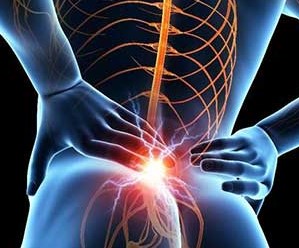
A rise in sedentary lifestyles is causing increased tension in the lower back muscles due to prolonged periods of sitting, sometimes compressing nerves, and an estimated 10-25% of people with lower back pain have sacroiliitis. Sacral pain can also be caused by prolonged periods of standing.
WHAT IS SACROILIITIS?
• inflammation of one/ both sacroiliac joints — these SI joints are situated where the triangular section of the lower spine connects with the ilium (rounded bones on the upper rear of the pelvis)
• causes lower back pain, but also may extend to buttocks or down one/both legs
• diagnosis can be difficult due to:-
i. many other inflammatory conditions causing pain in the same area - it has been linked to arthritis of the spine and can also misdiagnosed as a slipped disc
ii. the lower back has an extensive musculature involved in postural stability and flexion/extension, some of which may refer pain away from the sacral area
ANATOMY
• the sacrum is the triangular-shaped bone of the lower spine between the two hip bones, and consists of 5 fused pieces of bone
• forms part of the pelvic girdle, which protects internal organs
• the sacrum has 4 holes on either side which allow nerves and blood vessels to pass through
• works alongside gluteal and hip flexor muscles to assist with leg movement
• helps to provide space to allow the passage of the foetus during childbirth
CAUSES OF SACROILIITIS & SACROILIAC PAIN
1)NON-ARTHRITIC CAUSES
• TRAUMA/REPEATED INJURY - injury to the sacroiliac joint, ligament tension/laxity and/or spasm of the sacrococcygeal muscles due to an impact forcing them into unusual positions - eg.due to stepping awkwardly on a stair, car accident or a fall
• PREGNANCY - relaxin and progesterone relax the pelvic muscles and ligaments to accommodate the growing foetus and labour, but occasionally laxity in the ligaments causes pain due to the sacroiliac joint slipping out of place. The weight of pregnancy and altered posture also place extra stress on the ligaments
• EXTERNAL ENDOMETRIOSIS - when endometrial tissue migrates outside the uterus, potentially to sacro-uterine ligaments and behind the cervix
• SUSTAINED PHYSICAL ACTIVITY - continuous physical workout can strain the lower back muscles and shrink the rectal-uterine ligaments
• INFECTION - introduction of pyogenic microorganisms into the sacroiliac joint due to urinary tract infection, skin infections etc
• SPINAL ABNORMALITY (CONGENITAL OR ACQUIRED) - may arise during spinal development in the womb, usually in the lumbar-sacral vertebrae , causes sudden pain when a load is exerted on the spine
• METABOLIC BONE DISEASE - eg.osteoporosis orosteomalacia which may cause bone loss leading to injury and pain
• PROSTATE CONDITIONS - chronic prostatitis or prostate cancer with bone metastasis
• IV DRUG USE
• MECHANICAL STRESS - degenerative changes due to additional stress on a compromised joint eg.due to long-term severe arthritis or surgical spinal fusion
2)ARTHRITIC CAUSES
• RHEUMATOID ARTHRITIS & RHEUMATOLOGICAL CONDITIONS eg. lupus
• OSTEOARTHRITIS - wear-and-tear can occur in the sacroiliac joints and involve the breakdown of ligaments or cartilage. Advanced age, obesity, trauma,repetitive stress or postural misalignment will worsen the condition
• ANKYLOSING SPONDYLITIS - genetic inflammatory arthritic condition which originates in the sacroiliac joints before progressing up the spine, causing inflammation, erosion, and calcification
• PSORIATIC ARTHRITIS - an inflammatory joint condition causing scaly psoriasis, and pain and inflammation of the spinal joints, occurring in approximately 10% of those with psoriasis
• GOUT - an inflammatory arthritis caused by uric acid crystals building up in the joints
SYMPTOMS
• Sharp or dull pain, generally in the buttocks and lower back, but may also affect the legs, groin and even the feet
• pain may be unilateral or bilateral
• pain is aggravated by:-
- long periods of sitting or standing
- transitional movements eg. getting out of a chair
- climbing stairs
- weight bearing on one leg more than the other
- taking large strides
- running
- any rotational hip movements
• numbness/tingling/weakness in the leg may arise due to nerve compression
TREATMENT
Treatment will be influenced by symptoms and the cause of your sacroiliitis. Usually rest, medication and staying active is enough to resolve the pain. If untreated, sacroiliitis can lead to chronic pain in other areas.
• REST – may help reduce inflammation in sacroiliac joints
• HEAT/ICE – alternating heat and ice packs can ease pain and inflammation, and promote healing by stimulating blood flow. Ice packs should only be used for 15–20 minutes at a time
• SLEEPING – changing to a side sleeping position with a pillow between the knees may ease pain
• MEDICATION :-
- non-steroidal anti-inflammatories for pain relief
- vitamin D and calcium supplements if sacroiliitis is due to bone weakness
- muscle relaxants may reduce any muscle spasms
- Tumor necrosis factor (TNF) inhibitors often relieve sacroiliitis with ankylosing spondylitis
• wearing a medical brace to help support the bone structure
• PHYSIOTHERAPY/MASSAGE THERAPY- to strengthen and stabilize the muscles supporting the sacroiliac joints, improve range of motion, and ease lower back pain.
• HYDROTHERAPY - may help maintain flexibility without placing stress on the back muscles
If the above treatments don’t work:-
• STEROID INJECTIONS - corticosteroids can be injected into the SI joint to reduce inflammation and pain, but only in severe cases as they can weaken bones and tendons
• RADIOFREQUENCY DENERVATION - can destroy the nerve tissue that is causing pain
• ELECTRICAL STIMULATION - implanting an electrical stimulator into the sacrum may ease reduce pain
• JOINT FUSION - fusing the two SI bones together with metal hardware can relieve sacroiliitis pain in rare cases
PREVENTION
While you can’t prevent sacroiliitis, you can improve recovery and reduce symptoms by:-
• avoiding activities that cause the pain eg. running, stair climbing
• lead a physically active lifestyle
• modified work duties may be beneficial for a short time
• ENSURE PROPER LIFTING TECHNIQUE– always bend at the knees rather than flexing only at the hip
• ENSURE GOOD SITTING POSTURE – maybe use a posture chair for prolonged periods of sitting
• WORKPLACE ERGONOMICS – make sure that work computer is in front of your eyes and feet are flat on the floor
• NUTRITION – deficiencies can lead to chronic aches and certain foods can increase gout symptoms if this is an issue
• BODY MASS INDEX -obesity places extra pressure on the sacral area resulting in chronic lower back pain
• GIVE UP/REDUCE SMOKING - smoking lessens the blood supply to tissues. Intervertebral discs naturally have a compromised blood supply, so heavy smokers are prone to back pain
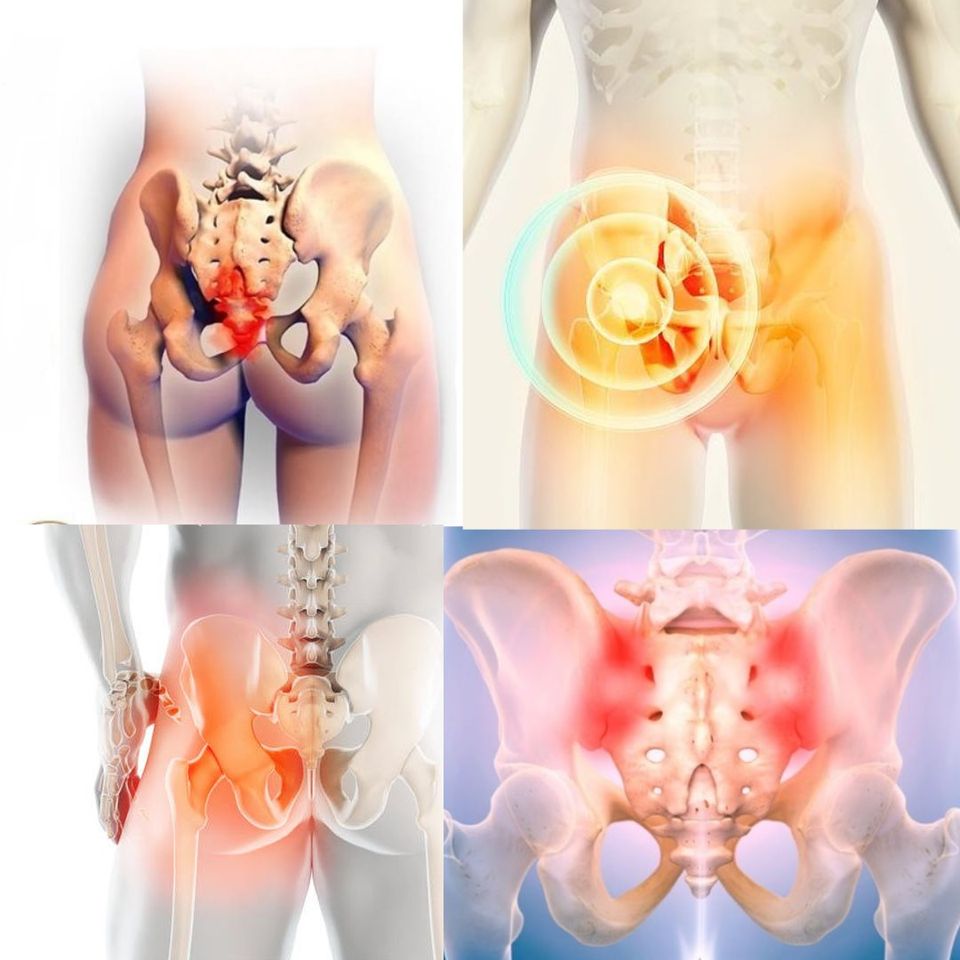
HOW MASSAGE HELPS
Numerous muscles attach to the sacrum and coccyx, and so sacral pain may be due to postural strain or muscular issues. The deep lateral rotators, hamstrings, hip flexors, and pelvic floor muscles can all cause pressure in the buttocks.
• by strengthening the supporting muscles, massage can help to stabilise the sacroiliac joints and improve range of motion
• by stretching tight hip flexors, hamstrings and glutes, massage can ease lower back pain by releasing accumulated tension from prolonged sitting and standing
EXERCISES
Moderate intensity exercises help maintain the flexibility of the spine.
• QUADS STRETCH
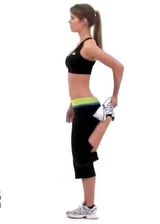
– stand holding onto something for support, bend the knee and use your hand to grab onto your foot and gently pull in towards buttocks. Push forward at the hip on the same side to feel a stretch in the front of your thigh. Hold this position 5-10 seconds and release gently.
• PRONE LEG LIFTS
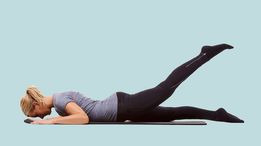
- laying on your stomach, use glutes and hamstrings to raise your leg as far as possible, hold, then lower back down. Repeat this exercise a few times.
• HIP STRETCH
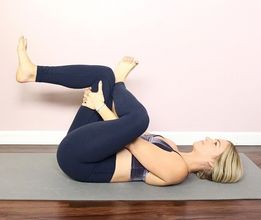
- lay on your back and slide one foot as far as possible up the opposite leg, externally rotating the hip, and forming a “figure four” position with the legs. Hold for a few seconds, then slide foot back down. For a greater stretch to the deep lateral rotators, you can then pull the bottom leg towards you, supporting under the lower thigh. Repeat a few times a day.
• KNEE ROTATION
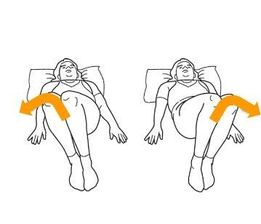
- laying on your back with knees bent and feet flat on the floor, allow your knees to gently pull to the left, keeping lower back into the floor. Hold for a few seconds, and then return the knees to the centre. Repeat by pulling knees to the right. Repeat 8-10 times.
• BRIDGING
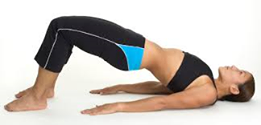
- lying on your back with knees bent and feet flat on the ground, squeeze your buttocks and raise your hips off the ground, thrusting into the air. Keep palms flat on the ground by your sides. Hold for five seconds then slowly lower yourself down. Repeat 8- 10 times.
• CHILD YOGA POSE
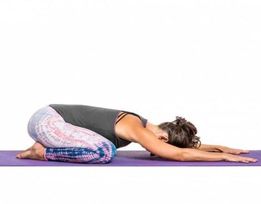
- on your hands and knees, with buttocks resting on heels, extend your arms with palms facing down , reaching as far forward as you can.
• BIRD DOG YOGA POSE
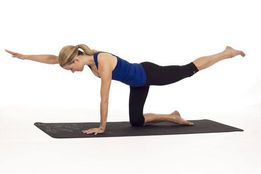
- work the lower back and abdominal muscles. Start on all fours, keeping spine and neck in neutral position and looking down at the ground. Slowly extend your right leg behind you while simultaneously extending your left arm forward. While keeping your back straight, hold for 5 seconds. Repeat 6 – 10 times each side.
